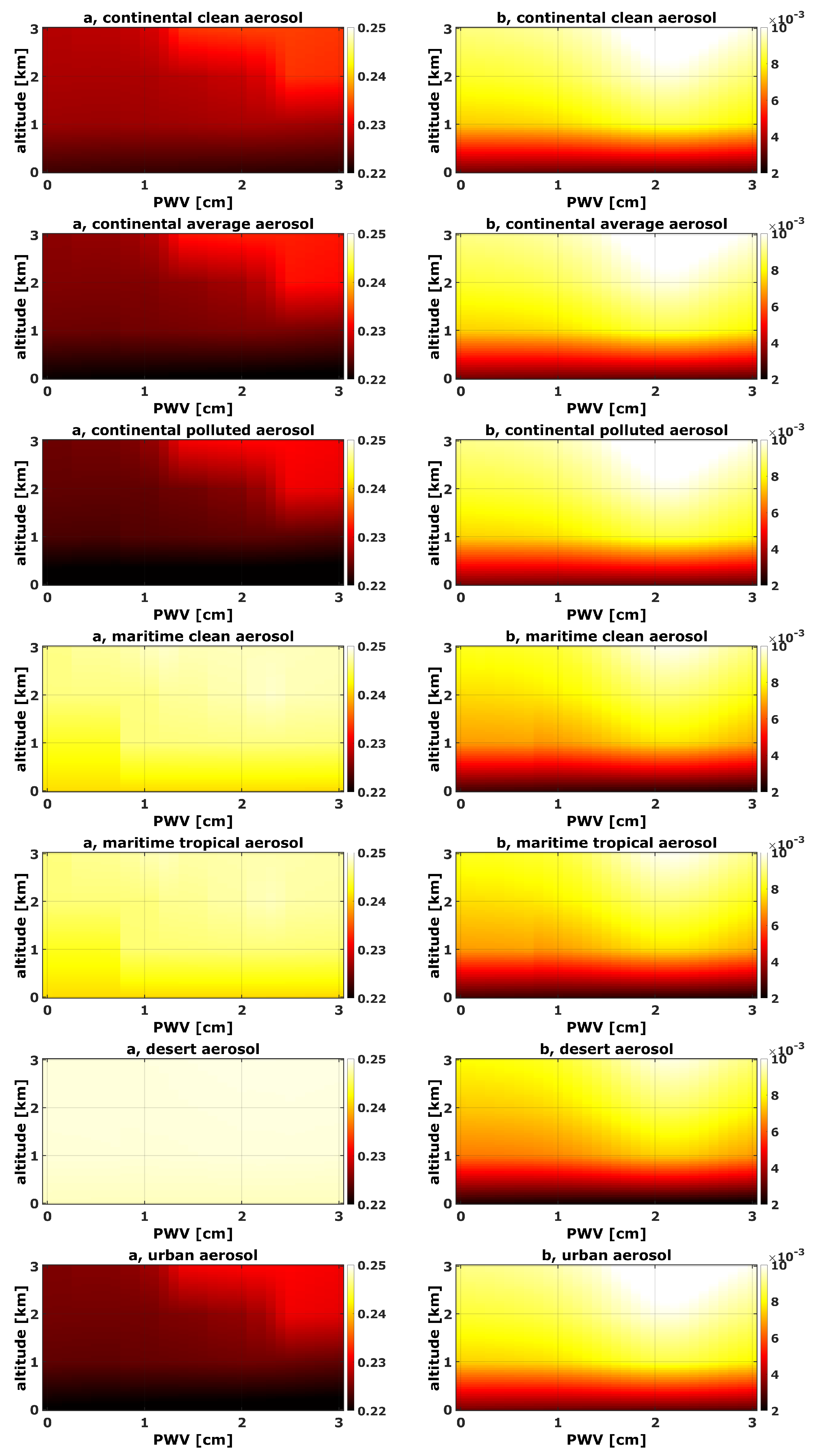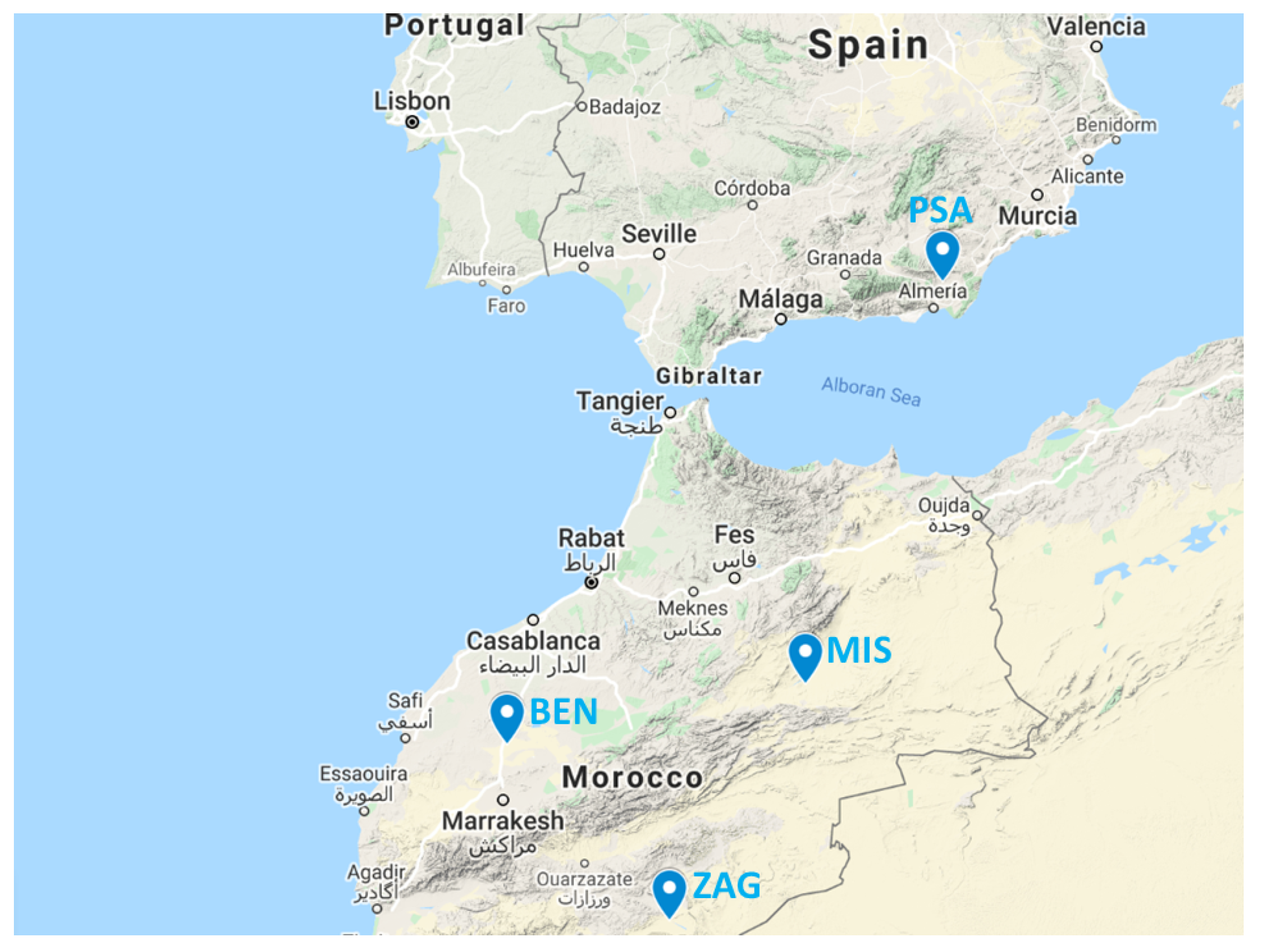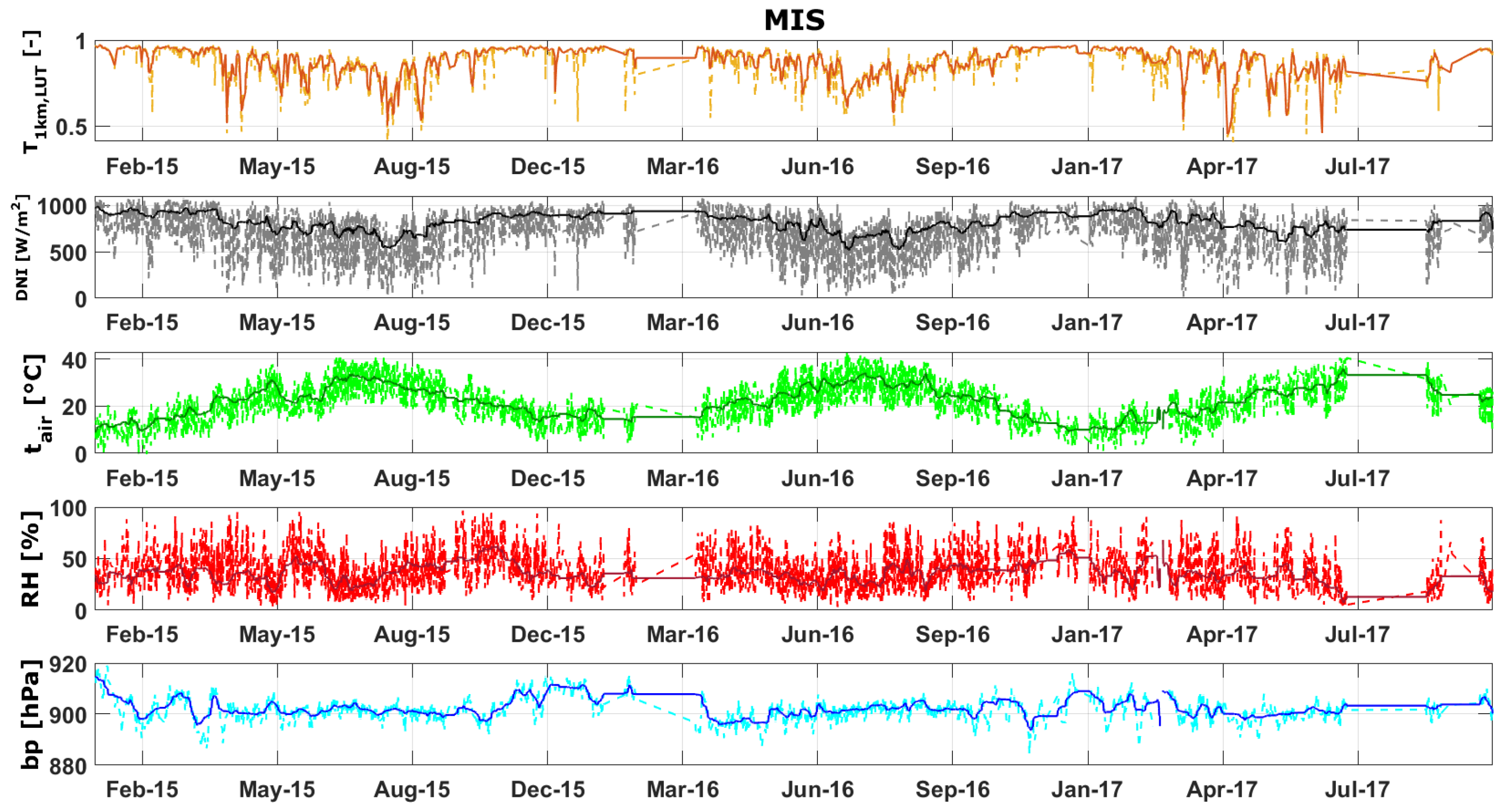AATTENUATION—The Atmospheric Attenuation Model for CSP Tower Plants: A Look-Up Table for Operational Implementation
Abstract
1. Introduction
2. DNI Based AATTENUATION Model Look-Up Table
2.1. AATTENUATION Model Concept
2.2. Look-Up Table Development
2.2.1. Radiative Transfer Simulations
2.2.2. Standard Aerosol Type Mixtures Simulated
- Continental aerosol type mixtures: While the continental clean aerosol represents remote continental areas with very low anthropogenic influences and thus no soot contribution to the aerosol mass mixing ratio composition (around 59% water-soluble and 41% insoluble particles), the continental average aerosol describes anthropogenically influenced continental areas with soot and increased insoluble and water-soluble component amounts (58% water-soluble, 40% insoluble particles, and 2% soot mass mixing ratio). The continental polluted standard aerosol is defined by an increased soot mass density and the mass density of water-soluble substances is more than double than in continental average conditions (66% water-soluble, 30% insoluble, and 4% soot in terms of mass mixing ratios).
- Maritime aerosol type mixtures: The maritime aerosol types mainly contain sea salt particles in the coarse and accumulation mode. The maritime clean aerosol represents maritime conditions without soot but some amount of water-soluble aerosol particles to represent non-sea salt sulfate (mass mixing ratios of 91% sea salt of accumulation mode, 1% coarse sea salt, and 7% water-soluble aerosol). In tropical maritime environments, a lower density of water-soluble substances is assumed (93% sea salt in accumulation mode, 1% sea salt in coarse mode, and 6% water-soluble mass mixing ratio).
- Desert aerosol type mixture: The standard desert aerosol composition consists according to Reference [26] of mineral aerosol and water-soluble components (2% water-soluble particles, 3% mineral particles in nucleation, 75% in accumulation, and 20% in coarse mode).
- Urban aerosol type mixture: Strong pollution in urban areas is represented by the urban aerosol mixture (56% water-soluble, 36% insoluble, and 8% soot mass mixing ratio).
2.2.3. Standard Atmospheres and Radiative Transfer Solvers Simulated
2.2.4. Chosen Extinction Height Profile
3. AATTENUATION Model Look-Up Table Discussion for Different Aerosol Types
4. AATTENUATION Model Look-Up Table Validation at 4 Sites in Morocco and Spain
4.1. Reference Data Set
4.2. LUT Validation Results
5. How to Apply the AATTENUATION Model and Its Look-Up Table?
- Choose standard atmosphere according to site location: The AATTENUATION model LUT is provided for two different AFGL standard atmosphere files according to Reference [27], which include information about the vertical gas profiles, as well as RH, , and bp. The LUT is available for the standard mid-latitude summer atmosphere (afglms, to be applied for latitudes until larger than 23° or smaller than −23°) and the AFGL tropical atmosphere for the remaining latitudes in the tropics (afglt, for latitude between −23° and 23°). If you are unsure which atmosphere to use, the model can also be quickly evaluated for both AFGL atmospheres to define a range of possible attenuations. However, the effect of the atmosphere is not significant compared to the aerosol type and model uncertainty.
- Choose prevailing aerosol type according to site location: The LUT is provided for several standard aerosol type mixtures which are defined in Reference [26] and also briefly described in Section 2.2. The LUT is provided for the aerosol type mixture “continental clean”, “continental average”, “continental polluted”, “maritime clean”, “maritime tropical”, “urban”, and “desert”. According to the conditions at the site of interest, one aerosol type mixture can be chosen as an expert guess. Alternatively also several simulations can be carried out to indicate a range of possible attentuations.
- Filter the DNI time series for clouds: A cloud detection algorithm has to be applied to detect cloudy time steps because the AATTENUATION model can only be used for cloud free conditions. An example on how to detect clouds using the TL is described in Reference [19]. The TL coefficient represents the number of dry and clean atmospheres which are producing the observed extinction [37]. To detect cloudy time steps, an upper limit of TL, as well as a limit for the temporal variability of TL, can be defined. In Reference [19], rather conservative cloud detection TL limits were selected for PSA (upper threshold of 13 and temporal variability threshold for 1 min resolved data of 0.02) to avoid outliers which are caused by cloud influenced data points. These thresholds have to be chosen individually for the site of interest.
- Calculate the PWV for time series: For each time step of interest, the PWV within the atmospheric column above the site of interest has to be calculated, e.g., according to the empirical equation of Reference [25]. The equation uses the measured and the saturated water vapor pressure which can be calculated from , RH, and bp using the approach described in Reference [24].
- Find closest altitude grid point for the site of interest: The LUT was created for an altitude grid (a.m.s.l.) with a resolution of 100 m. For the site of interest, the closed altitude grid point has to be found to choose the correct from the LUT. For higher accuracies of the AATTENUATION model, the from two grid points can be linearly interpolated according to the actual altitude of the site of interest.
- Consider Earth-Sun distance: As the from the LUT was simulated and is provided only for 21 June, the effect that the extraterrestrial irradiance varies throughout the year due to the changing sun-earth distance has to be considered. Therefore, the chosen has to be scaled accordingly. Reference [19] proposes to scale on a daily basis by calculating the daily squared ratio between the Earth-Sun distance on 21 June () and the actual Earth-Sun distance of the day ():The from the LUT is than multiplied by this ratio. These daily ratios, which were calculated according to Reference [38], are provided with the LUT.
- Calculate the SZA for each time step: The SZA has to be calculated for the whole time series because, according to the time-dependent SZA, has to be chosen to be used in Equation (3). This can be done by, e.g., applying the Michalsky code [39] and NREL’s SOLPOS code (https://www.nrel.gov/grid/solar-resource/solpos.html), which was done for the evaluation presented in this manuscript, or, e.g., the solar position code of Reference [40] can be used.
- Choose AATTENUATION model LUT parameters for each time step: For each time step from the time series of interest, the parameters a, b and can now be chosen from the LUT according to the current PWV, SZA, the site altitude and the assumed prevailing aerosol type. These parameters can then be applied in Equation (3) to calculate the time-dependent attenuation or transmittance dependent on the slant range.
- Scale the extinction coefficient: If no further adjustments are made, an extinction profile with a constant aerosol extinction coefficient up to 1 km above the ground and no extinction above 1 km will be assumed. If necessary, this constant extinction layer thickness can be scaled now according to the site specific conditions, e.g., by considering the BLH from other sources. To scale the extinction coefficient, a scaling factor of 1/BLH can be added to Formula (2).
- Extent attenuation simulations to SZA larger than 80°: The AATTENUATION LUT is provided only for SZA of less than 80°. The DNI curve is for cloud free days rather steep between 80 and 90° and small measurement errors in DNI will have a large impact on the modeled attenuation than for lower SZA. Therefore, no LUT is provided for these high SZA. Different strategies can be followed to approximate the attenuation for the time steps with SZA between 80° and 90° when a small part of solar radiation is still available. For the LUT generation, this effect was neglected as these SZAs are of low importance for CSP yield calculations. The recommended strategy to derive attenuation simulations for SZA between 80° and 90° is to use the last simulated attenuation value of each day for the time steps between SZA equal to 80° and 90° in the afternoon. In the morning, the first calculated attenuation value can be applied for all previous data point of SZA between 80° and 90°.
6. Conclusions
Supplementary Materials
Author Contributions
Funding
Acknowledgments
Conflicts of Interest
Acronyms
| AATTENUATION | Atmospheric Attenuation |
| AOD | aerosol optical depth |
| BEN | Benguerir, Morocco |
| BLH | boundary layer height |
| bp | barometric pressure |
| CSP | concentrated solar power |
| DNI | direct normal irradiance |
| EPC | engineering, procurement and construction |
| LUT | look-up table |
| MBE | mean bias error |
| MENA | Middle East and northern African |
| MIS | Missour, Morocco |
| PSA | Plataforma Solar de Almería |
| PWV | precipitable water vapor |
| RH | relative humidity |
| RMSE | root mean square error |
| SZA | solar zenith angle |
| Tair | ambient temperature |
| T1km | broadband transmittance for a slant range of 1 km |
| TL | Linke turbitidy |
| ZAG | Zagora, Morocco |
References
- Washington, R.; Todd, M.; Middleton, N.; Goudie, A.S. Dust-Storm Source Areas Determined by the Total Ozone Monitoring Spectrometer and Surface Observations. Ann. Assoc. Am. Geogr. 2003, 93, 297–313. [Google Scholar] [CrossRef]
- Abengoa. 2015. Available online: http://www.abengoasolar.com (accessed on 15 January 2015).
- Torresol. 2015. Available online: http://www.torresolenergy.com (accessed on 15 January 2015).
- Brightsource. 2015. Available online: http://www.ivanpahsolar.com/ (accessed on 15 January 2015).
- Hanrieder, N.; Wilbert, S.; Mancera Guevara, D.; Buck, R.; Giuliano, S.; Pitz-Paal, R. Atmospheric extinction in solar tower plants—A Review. Sol. Energy 2017, 152, 193–207. [Google Scholar] [CrossRef]
- Hanrieder, N.; Ghennioui, A.; Alami Merrouni, A.; Wilbert, S.; Wiesinger, F.; Sengupta, M.; Zarzalejo, L.; Schade, A. Atmospheric Transmittance Model Validation for CSP Tower Plants. Remote Sens. 2019, 11, 1083. [Google Scholar] [CrossRef]
- IRENA. International Renewable Energy Agency, Africa 2030: Roadmap for a Renewable Energy Future; Report; IRENA: Abu Dhabi, UAE, 2015. [Google Scholar]
- Polo, J.; Ballestrín, J.; Carra, E. Sensitivity study for modelling atmospheric attenuation of solar radiation with radiative transfer models and the impact in solar tower plant production. Sol. Energy 2016, 134, 219–227. [Google Scholar] [CrossRef]
- Polo, J.; Ballestrín, J.; Alonso-Montesinos, J.; López-Rodriguez, G.; Barbero, F.; Carra, E.; Fernández-Reche, J.; Bosch, J.; Batlles, F. Analysis of solar tower plant performance influenced by atmospheric attenuation at different temporal resolutions related to aerosol optical depth. Sol. Energy 2018, 157. [Google Scholar] [CrossRef]
- Armijo, K.; Shinde, S. Heat Transfer Phenomena in Concentrating Solar Power Systems; SAND2016-11399; Sandia National Lab. (SNL-NM): Albuquerque, NM, USA, 2016. [CrossRef]
- Tasbirul Islam, M.; Huda, N.; Abdullah, A.; Saidur, R. A comprehensive review of state-of-the-art concentrating solar power (CSP) technologies: Current status and research trends. Renew. Sustain. Energy Rev. 2018, 91, 987–1018. [Google Scholar] [CrossRef]
- Elias, T.; Ramon, D.; Garnero, M.A.; Dubus, L.; Bourdil, C. Solar Energy Incident at the Receiver of a Solar Tower Plant, Derived from Remote Sensing: Computation of Both DNI and Slant Path Transmittance. In AIP Conference Proceedings; AIP Publishing LLC: Melville, NY, USA, 2017. [Google Scholar]
- Elias, T.; Ramon, D.; Brau, J.; Moulana, M. Sensitivity of the Solar Resource in Solar Tower Plants to Aerosols and Water Vapor. In AIP Conference Proceedings; AIP Publishing LLC: Melville, NY, USA, 2018. [Google Scholar]
- Lopez, G.; Gueymard, C.; Bosch, J.L. Evaluation of Solar Energy Losses for the Heliostat-To-Receiver Path of a Tower Solar Plant for Different Aerosol Models; Solar World Congress: Abu Dhabi, UAE, 2017. [Google Scholar]
- Lopez, G.; Gueymard, C.; Bosch, J.L.; Rapp-Arraras, I.; Alonso-Montesinos, J.; Pulido-Calvo, I.; Ballestrín, J.; Polo, J.; Barbero, J. Modeling Water Vapor Impact on the Solar Energy Reaching the Receiver of a Solar Tower Plant by means of Artificial Neural Networks. Sol. Energy 2018, 169, 34–39. [Google Scholar] [CrossRef]
- Gueymard, C.; Lopez, G.; Rapp-Arraras, I. Atmospheric Transmission Loss in Mirror-To-Tower Slant Ranges Due to Water Vapor. In AIP Conference Proceedings; AIP Publishing LLC: Melville, NY, USA, 2017. [Google Scholar]
- Carra, E.; Ballestrín, J.; Polo, J.; Barbero, F.; Fernández-Reche, J. Atmospheric extinction levels of solar radiation at Plataforma Solar de Almería. Application to solar thermal electric plants. Energy 2018, 145, 400–407. [Google Scholar] [CrossRef]
- Polo, J.; Alonso-Montesinos, J.; López-Rodriguez, G.; Bosch, J.; Barbero, F.; Carra, E.; Fernández-Reche, J.; Batlles, F.; Ballestrín, J. Modelling atmospheric attenuation at different AOD time-scales in yield performance of solar tower plants. In AIP Conference Proceedings; AIP Publishing LLC: Melville, NY, USA, 2018; Volume 2033, p. 190013. [Google Scholar] [CrossRef]
- Hanrieder, N.; Sengupta, M.; Xie, Y.; Wilbert, S.; Pitz-Paal, R. Modelling Beam Attenuation in Solar Tower Plants Using Common DNI Measurements. Sol. Energy 2016, 129, 244–255. [Google Scholar] [CrossRef]
- Vindel, J.; Polo, J.; Zarzalejo, L.; Ramirez, L. Stochastic model to describe atmospheric attenuation from yearly global solar irradiation. Atmos. Res. 2015, 153, 205–216. [Google Scholar] [CrossRef]
- Sengupta, M.; Wagner, M. Impact of Aerosols on Atmospheric Attenuation Loss in Central Receiver Systems. In AIP Conference Proceedings; AIP Publishing LLC: Melville, NY, USA, 2012. [Google Scholar]
- Mayer, B.; Kylling, A. Technical note: The libRadtran software package for radiative transfer calculations-description and example of use. Atmos. Chem. Phys. 2005, 5, 1855–1877. [Google Scholar] [CrossRef]
- Emde, C.; Buras-Schnell, R.; Kylling, A.; Mayer, B.; Gasteiger, J.; Hamann, U.; Kylling, J.; Richter, B.; Pause, C.; Dowling, T.; et al. The libRadtran software package for radiative transfer calculations (version 2.0.1). Geosci. Model Dev. 2016, 9, 1647–1672. [Google Scholar] [CrossRef]
- Gueymard, C. Assessment of the Accuracy and Cumputing Speed of Simplified Saturation Vapor Equations Using a New Reference Dataset. J. Appl. Meteorol. 1993, 32, 1294–1300. [Google Scholar] [CrossRef]
- Gueymard, C. Analysis of monthly average atmospheric precipitable water and turbidity in Canada and Northern United States. Sol. Energy 1994, 53, 57–71. [Google Scholar] [CrossRef]
- Hess, M.; Köpke, P.; Schult, I. Optical Properties of Aerosols and Clouds: The Software Package OPAC. Bull. Am. Soc. 1998, 79, 831–844. [Google Scholar] [CrossRef]
- Anderson, G.; Clough, S.; Kneizys, F.X.; Chetwynd, J.; Shettle, E. AFGL Atmospheric Constituent Profiles (1–120 km); Environmental Research Papers; AFGL-TR-89-0110; Air Force Geophysics Laboratory: Bedford, MA, USA, 1986; Volume 954. [Google Scholar]
- Gasteiger, J.; Emde, C.; Mayer, B.; Buras, R.; Buehler, S.; Lemke, O. Representative wavelengths absorption parametrization applied to satellite channels and spectral bands. J. Quant. Spectrosc. Radiat. Transf. 2014, 148, 99–115. [Google Scholar] [CrossRef]
- Kurucz, R. Synthetic infrared spectra. In Proceedings of the 154th Symposium of the International Astronomical Union (IAU), Tucson, AZ, USA, 2–5 March 1992; Kluwer, Acad.: Norwell, MA, USA, 1992. [Google Scholar]
- Stamnes, K.; Tsay, S.; Wiscombe, W.; Jayaweera, K. Numerically stable algorithm for discrete-ordinate-method radiative transfer in multiple scattering and emitting layered media. Appl. Opt. 1988, 27, 2502–2509. [Google Scholar] [CrossRef]
- Buras, R.; Dowling, T.; Emde, C. New secondary-scattering correction in DISORT with increased efficiency for forward scattering. J. Quant. Spectrosc. Radiat. Transf. 2011, 112, 2028–2034. [Google Scholar] [CrossRef]
- Berrisford, P.; Dee, D.; Poli, P.; Brugge, R.; Fielding, K.; Fuentes, M.; Kallberg, P.; Kobayashi, S.; Uppala, S.; Simmons, A. The ERA-Interim archive Version 2.0; Report; ECMWF: Reading, UK, 2011. [Google Scholar]
- Lane-Veron, D.; Somerville, C.J. Stochastic theory of radiative transfer through generalized cloud fields. J. Geophys. Res. 2004, 109, D18113. [Google Scholar] [CrossRef]
- Kipp and Zonen. CHP1 Pyrheliometer Instruction Manual (Version 0811); KippZonen: Utrecht, The Netherlands, 2008. [Google Scholar]
- CSPServices. Twin RSI Description. 2020. Available online: https://www.cspservices.de/wp-content/uploads/Folleto_Twin_RSI.pdf (accessed on 17 July 2020).
- Hanrieder, N.; Wilbert, S.; Pitz-Paal, R.; Emde, C.; Gasteiger, J.; Mayer, B.; Polo, J. Atmospheric extinction in solar tower plants: Absorption and broadband correction for MOR measurements. Atmos. Meas. Tech. 2015, 8, 1–14. [Google Scholar] [CrossRef]
- Ineichen, P.; Perez, R. A new airmass indepentend formulation for the Linke turbidity coefficient. Sol. Energy 2002, 73, 151–157. [Google Scholar] [CrossRef]
- Liou, K. An Introduction to Atmospheric Radiation, 2nd ed.; International Geophysics Series; Academic Press: London, UK, 2002; Volume 84. [Google Scholar]
- Michalsky, J. The Astronomical Almanac’s algorithm for approximate solar position (1950–2050). Sol. Energy 1988, 40, 227–235, Erratum in 1988, 41, 113. [Google Scholar] [CrossRef]
- Blanc, P.; Wald, L. The SG2 algorithm for a fast and accurate computation of the position of the Sun for multi-decadal time period. Sol. Energy 2012, 86, 3072–3083. [Google Scholar] [CrossRef]
- Sengupta, M.; Wagner, M. Estimating atmospheric attenuation in central receiver systems. In Proceedings of the ASME 2012 6th International Conference on Energy Sustainability, San Diego, CA, USA, 23–26 July 2012. [Google Scholar]
- Sengupta, M.; Wagner, M. Atmospheric Attenuation in Central Receiver Systems from DNI Measurements. In AIP Conference Proceedings; AIP Publishing LLC: Melville, NY, USA, 2013. [Google Scholar]












| Site | PSA | MIS | ZAG | BEN |
|---|---|---|---|---|
| Latitude [° N] | 37.091 | 32.860 | 30.272 | 32.22153 |
| Longitude [° E] | −2.358 | −4.107 | −5.852 | −7.92798 |
| Altitude [m a.m.s.l.] | 500 | 1107 | 783 | 450 |
| Standard aerosol type | continental | continental | continental | continental |
| assumed | clean | clean | average | average |
© 2020 by the authors. Licensee MDPI, Basel, Switzerland. This article is an open access article distributed under the terms and conditions of the Creative Commons Attribution (CC BY) license (http://creativecommons.org/licenses/by/4.0/).
Share and Cite
Hanrieder, N.; Ghennioui, A.; Wilbert, S.; Sengupta, M.; Zarzalejo, L.F. AATTENUATION—The Atmospheric Attenuation Model for CSP Tower Plants: A Look-Up Table for Operational Implementation. Energies 2020, 13, 5248. https://doi.org/10.3390/en13205248
Hanrieder N, Ghennioui A, Wilbert S, Sengupta M, Zarzalejo LF. AATTENUATION—The Atmospheric Attenuation Model for CSP Tower Plants: A Look-Up Table for Operational Implementation. Energies. 2020; 13(20):5248. https://doi.org/10.3390/en13205248
Chicago/Turabian StyleHanrieder, Natalie, Abdellatif Ghennioui, Stefan Wilbert, Manajit Sengupta, and Luis F. Zarzalejo. 2020. "AATTENUATION—The Atmospheric Attenuation Model for CSP Tower Plants: A Look-Up Table for Operational Implementation" Energies 13, no. 20: 5248. https://doi.org/10.3390/en13205248
APA StyleHanrieder, N., Ghennioui, A., Wilbert, S., Sengupta, M., & Zarzalejo, L. F. (2020). AATTENUATION—The Atmospheric Attenuation Model for CSP Tower Plants: A Look-Up Table for Operational Implementation. Energies, 13(20), 5248. https://doi.org/10.3390/en13205248






